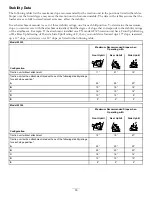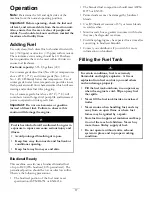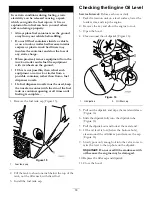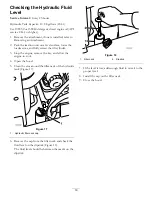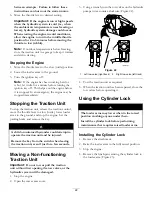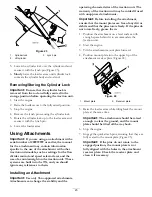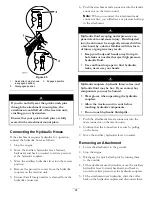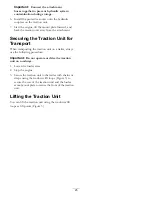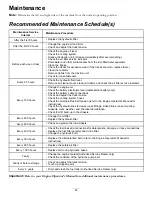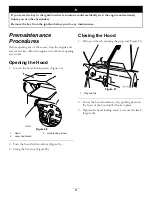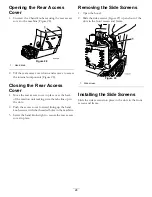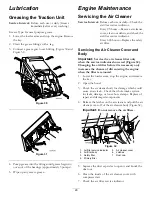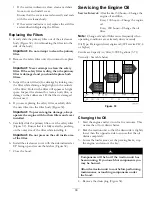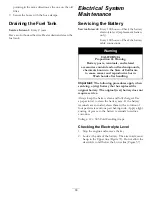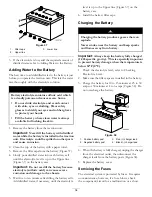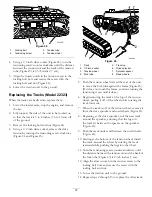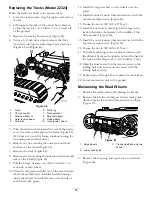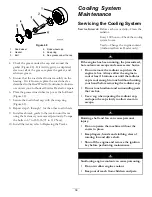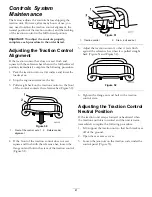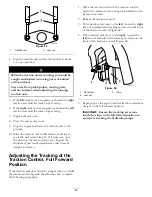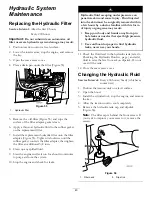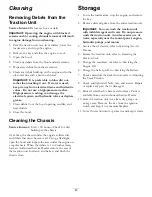
•
If the service indicator is clear, clean any debris
from cover and install cover.
Ensure that the cover is seated correctly and seals
with the air cleaner body.
•
If the service indicator is red, replace the air filter
as described in Replacing the Filters.
Replacing the Filters
1. Gently slide the primary filter out of the air cleaner
body (Figure 32). Avoid knocking the filter into the
side of the body.
Important:
Do not attempt to clean the primary
filter.
2. Remove the safety filter only if you intend to replace
it.
Important:
Never attempt to clean the safety
filter. If the safety filter is dirty, then the primary
filter is damaged and you should replace both
filters.
3. Inspect the new filter(s) for damage by looking into
the filter while shining a bright light on the outside
of the filter. Holes in the filter will appear as bright
spots. Inspect the element for tears, an oily film, or
damage to the rubber seal. If the filter is damaged
do not use it.
4. If you are replacing the safety filter, carefully slide
the new filter into the filter body (Figure 32).
Important:
To prevent engine damage, always
operate the engine with both air filters and cover
installed.
5. Carefully slide the primary filter over the safety filter
(Figure 32). Ensure that it is fully seated by pushing
on the outer rim of the filter while installing it.
Important:
Do not press on the soft inside area
of the filter.
6. Install the air cleaner cover with the side indicated as
UP facing up and secure the latches (Figure 32).
7. Close the hood.
Servicing the Engine Oil
Service Interval:
After the first 50 hours—Change the
engine oil and filter.
Every 100 hours—Change the engine
oil.
Every 200 hours—Change the oil
filter.
Note:
Change oil and oil filter more frequently when
operating conditions are extremely dusty or sandy.
Oil Type: Detergent diesel engine oil (API service CH-4
or higher)
Crankcase Capacity: w/filter, 0.98 US gallons (3.7 l)
Viscosity: See table below
Figure 33
Changing the Oil
1. Start the engine and let it run for five minutes. This
warms the oil so it drains better.
2. Park the traction unit so that the drain side is slightly
lower than the opposite side to ensure that the oil
drains completely.
3. Lower the loader arms, set the parking brake, stop
the engine, and remove the key.
Components will be hot if the traction unit has
been running. If you touch hot components you
may be burned.
Allow the traction unit to cool before performing
maintenance or touching components under
the hood.
4. Remove the drain plug (Figure 34).
30
Summary of Contents for 22319
Page 7: ...Slope Indicator 7...
Page 49: ...Schematics G007388 Electrical Schematic Rev B 49...
Page 50: ...Hydraulic Schematic Rev A 50...
Page 51: ...Notes 51...

